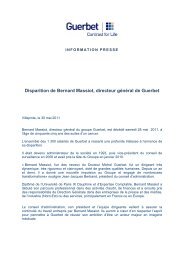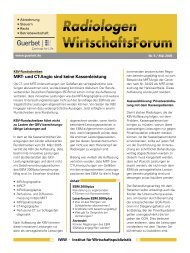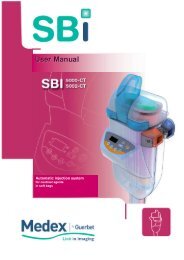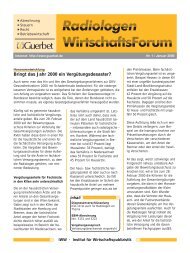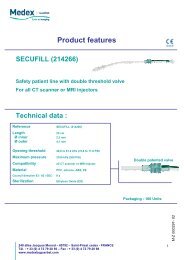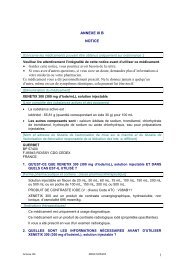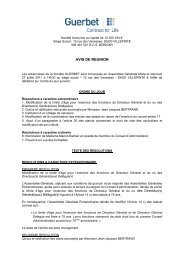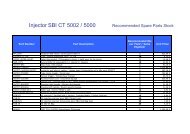Read the Registration Document - Guerbet
Read the Registration Document - Guerbet
Read the Registration Document - Guerbet
Create successful ePaper yourself
Turn your PDF publications into a flip-book with our unique Google optimized e-Paper software.
) Pollution and waste managementThe Group's Quality Safety Environment policy also involves a commitment to managing <strong>the</strong> environmentalimpacts of its manufacturing sites, in particular in terms of emissions, effluents or waste in order to preserve<strong>the</strong> natural environment.Since 2006, <strong>Guerbet</strong> Group has streng<strong>the</strong>ned its policy for waste management to guarantee traceability.Optimising channels for waste treatment, internal or external, also represents a major issue for effectiveoperational management of manufacturing sites.In 2012, 16,550 tonnes of hazardous waste were in this way processed externally. Projects in progress at<strong>the</strong> Lanester and Marans sites seek to insource a significant portion of <strong>the</strong> treatment of this hazardouswaste, while reducing <strong>the</strong> associated environmental impacts: reducing road traffic volume, increase <strong>the</strong>portion of effluents processed through biological methods ra<strong>the</strong>r than incineration (internally or externally).Standards governing waste and emissions applicable to manufacturing sites, and in particular <strong>the</strong> Sevesosites of Lanester and Marans, result in <strong>the</strong> application of numerous measures with respect to parameterscovering atmospheric emissions (volatile organic compounds, NOx, dust, etc.), liquid emissions andmonitoring soil.All results are used for guiding <strong>the</strong> operational activities of <strong>the</strong> installations, with alert thresholds making itpossible to detect and remedy anomalies. The results of this follow-up are communicated to <strong>the</strong> regionalregulatory authorities (DREAL) for Seveso sites, through monthly reports or specific reports: managementplan for solvents or annual environmental report.Finally, internal procedures and employee training make it possible to integrate regulatory developments,maintain <strong>the</strong> level of expertise for managing specific risks (transport of hazardous materials, manipulation ofchemical products, etc.), as well as respond to abnormal situations in order to limit <strong>the</strong>ir impacts.In 2012, awareness-raising measures on responsible practices continued with <strong>the</strong> implementation of apaper sorting system at <strong>the</strong> Aulnay site.c) Sustainable use of resourcesWater consumptionIn 2012, <strong>the</strong> water consumption of manufacturing sites (Aulnay, Lanester, Marans, Rio) remained stableat -0.3%, in relation to 2011 for a total volume of 284,558 m 3 . Since 2007, water consumption per unitproduced has been reduced by 24%.Aulnay Lanester Marans Rio de Janeiro TotalWater (in m3) 55,990 168,339 45,424 14,805 284,558Energy consumptionThe total energy consumption of its manufacturing sites (electricity, gas and fuel combined) rose marginallyby 1.2% from 2011. Measures to improve <strong>the</strong> energy efficiency of <strong>the</strong> Lanester site continued (withconsumption per unit produced down 5.9%), though this improvement was offset by <strong>the</strong> significant numberof equipment commissioned at <strong>the</strong> Aulnay site.A pilot programme "Energies Lanester" was initiated to achieve sustainable reductions in energyconsumption for this site and define good practices for efficient energy management both at technical andorganisational levels. This will also make it possible to support efforts by <strong>the</strong> Group to reduce greenhousegas emissions (see "Contributions to measures against global warming").67




